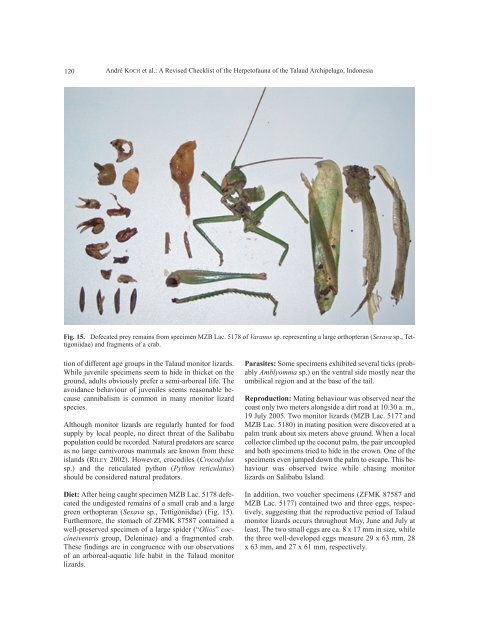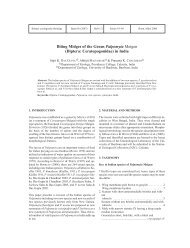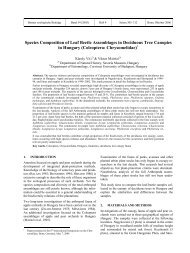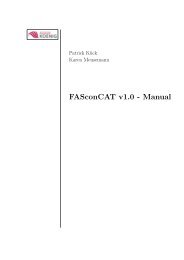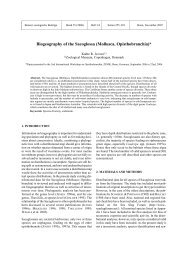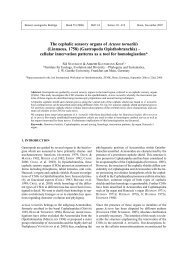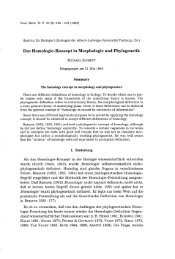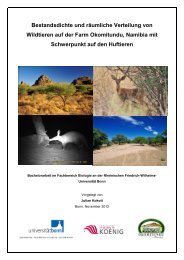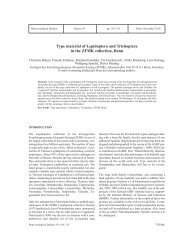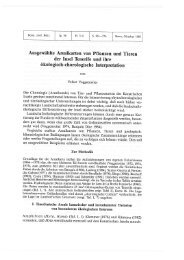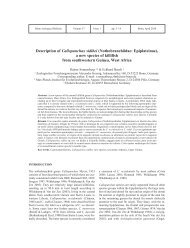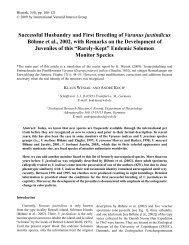Islands Between the Realms: A Revised Checklist of the ...
Islands Between the Realms: A Revised Checklist of the ...
Islands Between the Realms: A Revised Checklist of the ...
You also want an ePaper? Increase the reach of your titles
YUMPU automatically turns print PDFs into web optimized ePapers that Google loves.
120 André KOCH et al.: A <strong>Revised</strong> <strong>Checklist</strong> <strong>of</strong> <strong>the</strong> Herpet<strong>of</strong>auna <strong>of</strong> <strong>the</strong> Talaud Archipelago, Indonesia<br />
Fig. 15. Defecated prey remains from specimen MZB Lac. 5178 <strong>of</strong> Varanus sp. representing a large orthopteran (Sexava sp., Tettigoniidae)<br />
and fragments <strong>of</strong> a crab.<br />
tion <strong>of</strong> different age groups in <strong>the</strong> Talaud monitor lizards.<br />
While juvenile specimens seem to hide in thicket on <strong>the</strong><br />
ground, adults obviously prefer a semi-arboreal life. The<br />
avoidance behaviour <strong>of</strong> juveniles seems reasonable because<br />
cannibalism is common in many monitor lizard<br />
species.<br />
Although monitor lizards are regularly hunted for food<br />
supply by local people, no direct threat <strong>of</strong> <strong>the</strong> Salibabu<br />
population could be recorded. Natural predators are scarce<br />
as no large carnivorous mammals are known from <strong>the</strong>se<br />
islands (RILEY 2002). However, crocodiles (Crocodylus<br />
sp.) and <strong>the</strong> reticulated python (Python reticulatus)<br />
should be considered natural predators.<br />
Diet: After being caught specimen MZB Lac. 5178 defecated<br />
<strong>the</strong> undigested remains <strong>of</strong> a small crab and a large<br />
green orthopteran (Sexava sp., Tettigoniidae) (Fig. 15).<br />
Fur<strong>the</strong>rmore, <strong>the</strong> stomach <strong>of</strong> ZFMK 87587 contained a<br />
well-preserved specimen <strong>of</strong> a large spider (“Olios” coccineiventris<br />
group, Deleninae) and a fragmented crab.<br />
These findings are in congruence with our observations<br />
<strong>of</strong> an arboreal-aquatic life habit in <strong>the</strong> Talaud monitor<br />
lizards.<br />
Parasites: Some specimens exhibited several ticks (probably<br />
Amblyomma sp.) on <strong>the</strong> ventral side mostly near <strong>the</strong><br />
umbilical region and at <strong>the</strong> base <strong>of</strong> <strong>the</strong> tail.<br />
Reproduction: Mating behaviour was observed near <strong>the</strong><br />
coast only two meters alongside a dirt road at 10.30 a. m.,<br />
19 July 2005. Two monitor lizards (MZB Lac. 5177 and<br />
MZB Lac. 5180) in mating position were discovered at a<br />
palm trunk about six meters above ground. When a local<br />
collector climbed up <strong>the</strong> coconut palm, <strong>the</strong> pair uncoupled<br />
and both specimens tried to hide in <strong>the</strong> crown. One <strong>of</strong> <strong>the</strong><br />
specimens even jumped down <strong>the</strong> palm to escape. This behaviour<br />
was observed twice while chasing monitor<br />
lizards on Salibabu Island.<br />
In addition, two voucher specimens (ZFMK 87587 and<br />
MZB Lac. 5177) contained two and three eggs, respectively,<br />
suggesting that <strong>the</strong> reproductive period <strong>of</strong> Talaud<br />
monitor lizards occurs throughout May, June and July at<br />
least. The two small eggs are ca. 8 x 17 mm in size, while<br />
<strong>the</strong> three well-developed eggs measure 29 x 63 mm, 28<br />
x 63 mm, and 27 x 61 mm, respectively.


